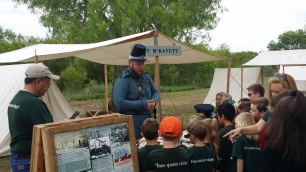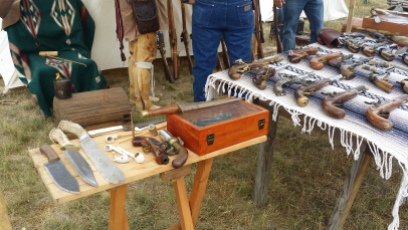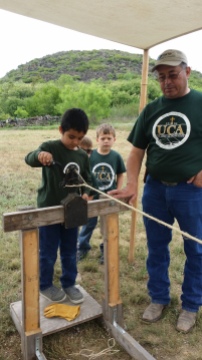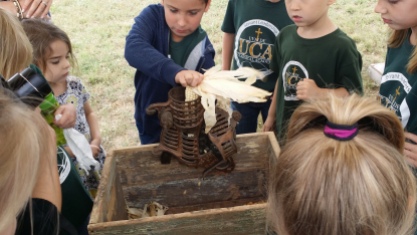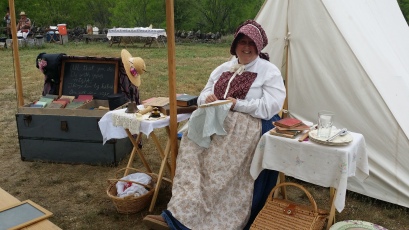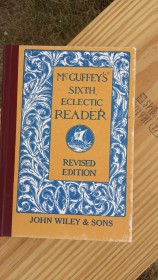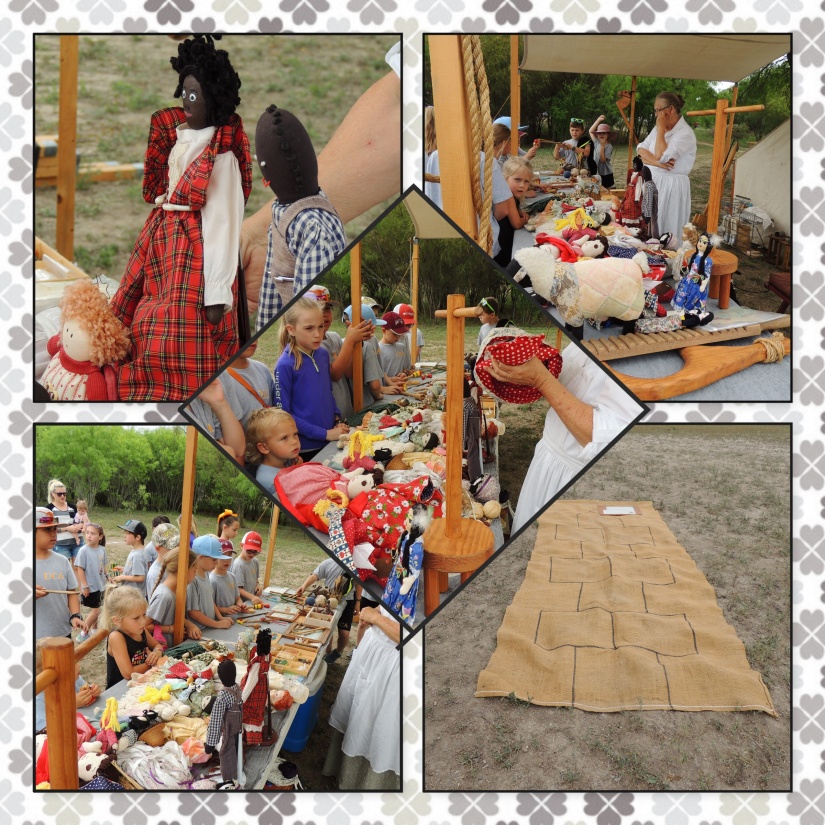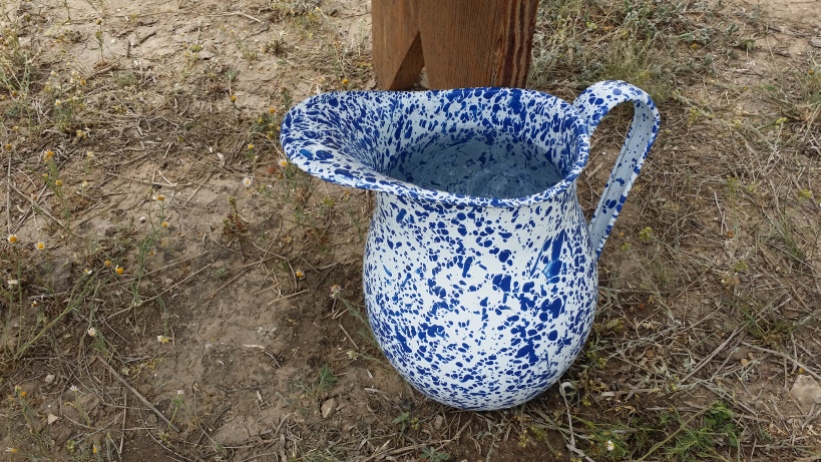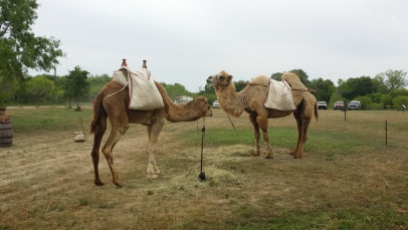My granddaughter’s school was invited to Fort Inge Living History Days just outside of Uvalde, TX for a field trip this spring and I was invited to tag along. We’ve actually gotten to do it for three years in a row now and this is my picture compilation from all of our visits.

FORT INGE. Fort Inge (also known as Camp Leona) is on the east bank of the Leona River a mile south of Uvalde in southern Uvalde County. The site is dominated by Mount Inge, a 140-foot volcanic plug of Uvalde phonolite basalt. Archeological evidence indicates the place has been intermittently occupied since the Pre-Archaic period, about 6,000 B.C. It is possible that ranching occurred there in the Spanish colonial and Mexican periods (see SPANISH TEXAS, MEXICAN TEXAS). On March 13, 1849, frontier artist Capt. Seth Eastman and fifty-six soldiers of companies D and I, First United States Infantry, established camp on the Leona, four miles above Woll’s Crossing. In December 1849 the post was renamed Fort Inge in honor of Lt. Zebulon M. P. Inge, United States Second Dragoons, a West Point officer killed at the Mexican War battle of Resaca de la Palma.
Fort Inge was established as a part of the first federal line of frontier forts in Texas. It was to serve as a base of operations for army troops and Texas militia. The missions of the soldiers included security patrols for the construction of the San Antonio-El Paso military road, escorts for supply trains and mail, protection for frontier settlements from bandits and Indian raiders, and guarding the international boundary with Mexico. The fort was a typical one-company, fifty-man post for most of its history. For a brief period in 1854 it was the regimental headquarters for the United States Mounted Rifle Regiment with a garrison of 200. One staff inspector reported that Fort Inge “is justly regarded as one of the most important and desirable positions in Texas. No station of the line possesses so many advantages as this . . . in point of wood, water, and soil . . . It is pre-eminent as a military site. [It is in] a state of constant warfare and constant service.”
Army units and officers of the post include the First Infantry Regiment (1849); Capt. William J. Hardee and Company C, Second Dragoons (1849–52); William A. A. (Bigfoot) Wallace‘s Texas Ranging Company (1850); the United States Mounted Rifle Regiment, under Col. William Wing Loring and captains Gordon Grangerand John G. Walker (1852–55); and the Second United States Cavalry, with Capt.Edmund Kirby Smith and lieutenants Fitzhugh Lee, Zenas R. Bliss, and William B. (Wild Bill) Hazen (1856–61). During the Civil War the post was occupied by Confederate and state units including Walter P. Lane‘s rangers; Company A, C.S.A. Cavalry; and John J. Dix‘s company, Norris Frontier Regiment. The fort was reoccupied by federal troops in 1866, and its final garrisons included Company K,Fourth United States Cavalry (1866–68); Company L, Ninth United States Cavalry; and Lt. John L. Bullis and Company D, Forty-first Infantry (1868–69). The Ninth Cavalry and Forty-first Infantry were black units.
The dozen buildings of the post were arranged around the rectangular parade ground with an enclosed stable at the south end of the post. The most substantial building was constructed of cut limestone and was used as a hospital and later as a storehouse. Most structures were of jacal construction-upright log pickets plastered with mud and whitewashed. A low, dry-stacked stone wall was built around the fort during or after the Civil War.
The establishment of the post in 1849 immediately attracted a number of farmers to the area. In 1853 Reading Wood Black bought land a mile upstream and began the settlement of Encina in 1855. The community was renamed Uvalde in 1856. Fort Inge was closed for federal service on March 19, 1869, and the garrison transferred to Fort McKavett. In 1871 United States troops returned to tear down some of the buildings and recover the timber and stone to be used in construction at Fort Clark. The site was used as a camp by the Texas Rangers until 1884. It was farmland until 1961, when it became Fort Inge Historical Site County Park. From 1980 to 1982 the Uvalde County Historical Commission and local donors sponsored archival research and an archeological project to establish an accurate and detailed history of Fort Inge.
BIBLIOGRAPHY: Arrie Barrett, Federal Military Outposts in Texas, 1846–1861 (M.A. thesis, University of Texas, 1927). George Collins, “Fort Inge,” Junior Historian, September 1950. George S. Nelson, Preliminary Archaeological Survey and Testing of Fort Inge, Texas (Uvalde, Texas: Uvalde County Historical Commission, 1981). Thomas Tyree Smith, Fort Inge (Austin: Eakin Press, 1993).
Handbook of Texas Online, Thomas T. Smith, “Fort Inge,” accessed April 27, 2016,http://www.tshaonline.org/handbook/online/articles/qbf27.
Published by the Texas State Historical Association
.
Our tour started with the Census taker…
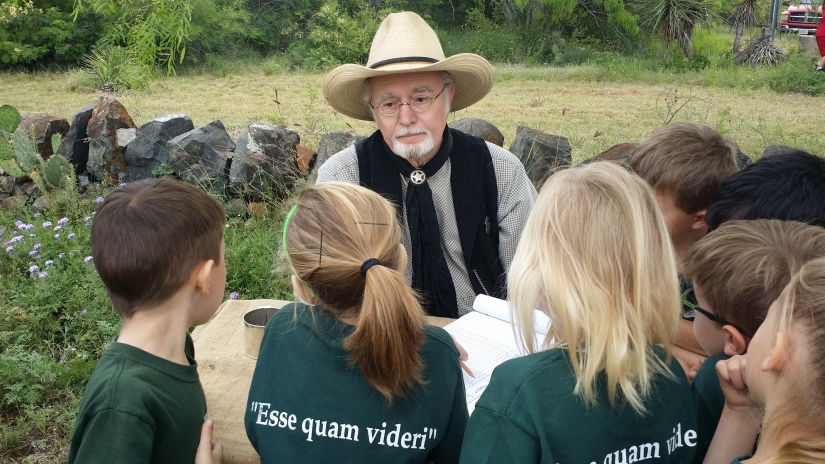
The 1850 census saw a dramatic shift in the way information about residents was collected. In 1850, the census began collecting “social statistics” (information about taxes, education, crime, and value of estate, etc.) and mortality data. For the first time, free persons were listed individually instead of by family. There were two questionnaires: one for free inhabitants and one for slaves. According to the US Census bureau these are the questions that would have been asked of persons being counted for the 1850 Census.
Schedule No. 1 – Free Inhabitants
Listed by column number, enumerators recorded the following information:
- Number of dwelling house (in order visited)
- Number of family (in order visited)
- Name
- Age
- Sex
- Color
This column was to be left blank if a person was White, marked “B” if a person was Black, and marked “M” if a person was Mulatto. - Profession, occupation, or trade of each person over 15 years of age
- Value of real estate owned by person
- Place of Birth
If a person was born in the United States, the enumerator was to enter the state they were born in. If the person was born outside of the United States, the enumerator was to enter their native country. - Was the person married within the last year?
- Was the person at school within the last year?
- If this person was over 20 years of age, could they not read and write?
- Is the person “deaf, dumb, blind, insane, idiotic, pauper, or convict?”
Schedule No. 2 – Slave Inhabitants
Slaves were listed by owner, not individually. Listed by column number, enumerators recorded the following information:
- Name of owner
- Number of slave
Each owner’s slave was only assigned a number, not a name. Numbering restarted with each new owner - Age
- Sex
- Color
This column was to be marked with a “B” if the slave was Black and an “M” if they were Mulatto. - Listed in the same row as the owner, the number of uncaught escaped slaves in the past year
- Listed in the same row as the owner, the number of slaves freed from bondage in the past year
- Is the slave “deaf and dumb, blind, insane, or idiotic?”

.
From there we wandered to the stations that were set up…

.
The first station on our tour was of the soldier’s quarters
Our tour guide had a display of the items in a typical soldier’s possession, along with a few items of what they mostly carried for rations, and then behind him was a small camp of the tents that they slept in.
On our second tour, the kids got to try on hats, and ask questions, and touch things. Once the kids learned all about the food and sleeping quarters, and what a soldier might carry on him on the battlefield, they were lined up for drills. Each student was given their own rifle (wooden replica) and then the hooligans were led through a series of drills. ATTENTION! Admittedly, they might need a little more practice, but not bad for their first time out.
.
Moving on to textiles…
At the next station the kids learned about yarn and thread and sowing and embroidery.
They learned about all the types of materials used to make thread and yarn, how it was brushed and washed to remove seeds and bugs and dirt, and then how it was spun into yarn or fine thread, which could then be woven into fabric and sewn into clothing, coats, hats, and under garments, as well as made into rugs or blankets and such.
.
And then we learned how folks kept all of their clothes and linens, and themselves, CLEAN!

The children learned about soup making: making lye, rendering fat, and adding perfumes; scrubbing and laundering, drying, ironing, and that whole lovely business. And boy did it smell good at that station!!!

.
Next on the tour was weaponry…
Here was a fairly massive display of hand guns, rifles, shotguns, hatchets, and knives, used for hunting and military action. The kids even got to touch things. Ha! Pretty cool!
.
We missed the firing of the cannon the first year of our tour, but on our third we had the good fortune of getting to experience all however many decibles of it.

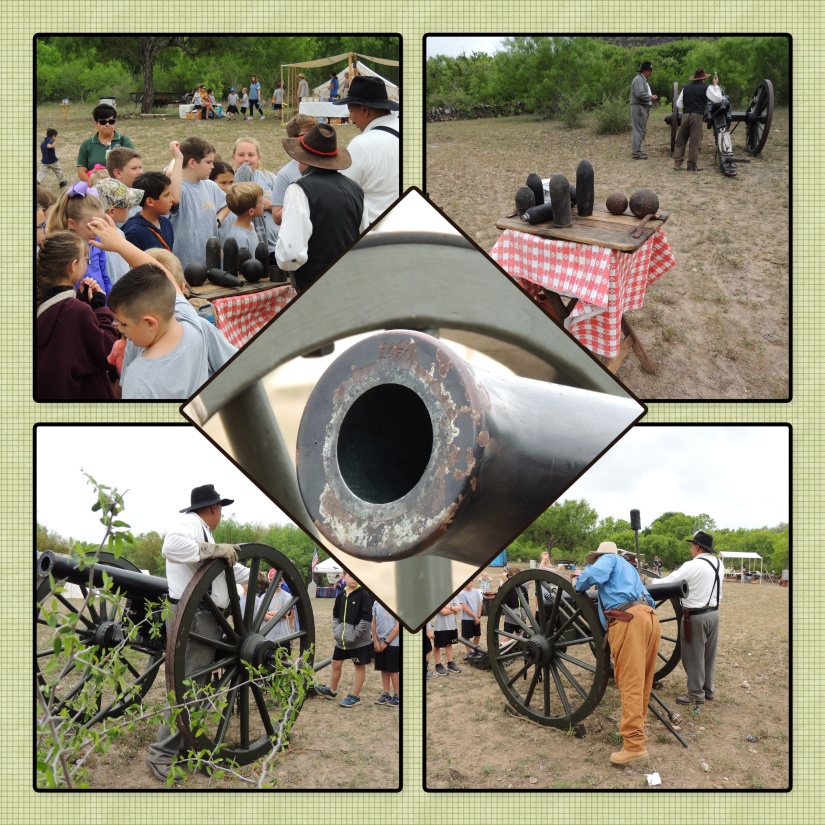
Here is a video of the cannon being fired at Fort Inge Living History Days from several years ago…
Holy moley! COVER YOUR EARS!
.
And next door to this was the Officer’s Quarters…
Like the soldier’s station, this one showed the items that were typical for an officer to have with him, and showed his slightly larger and nicer sleeping and private quarters.
.
At the next station the kids enjoyed doing some CHORES…
The kids learned about making rope, fetching water from a well, taking dried corn off the cob and grinding it into cornmeal.
.
Once they were finished with their chores they were allowed to run along to school…
…where they learned all about READING, WRITING, and ‘RITHMATIC!!! Teachers were required to be single back in those days and usually came from out-of-town and lived with a family in the community during the school season. The people of the community all chipped in to help pay her a salary, usually about $25 month. Children attended school when their chores were done, so they came and went all throughout the day. Students worked through their studies at their own pace, graduating to the next book once they were proficient in the beginner books. They practiced their handwriting and math problems on a slate with chalk. They also learned to write with pen and ink and the teacher gave a demonstration of the care of the pen and keeping of the ink, which was a precious thing in those days.
.
If there was any time left after chores and school, these were some of the toys that kids got to play with back in those days…
.
The next two stations were the kitchens…
In this kitchen the men were making stews and soups, hot coffee, and hot boiling water for dishwashing.

.
Next door to the hot stove was the other part of the kitchen, where the other preparations are made and the eating takes place…
In this kitchen our host was churning butter, and she told the kids about some of the baking and preserving (jams, jellies, pickles, etc.) done in those days.
She had made some molasses cookies and applesauce pies earlier that morning that made our mouths water.

She taught the kids about all sorts of period kitchen gadgets, and after we were gone, all of the volunteers would be sitting down to a nice prairie picnic of all the foods that were prepared in these kitchens that day. I loved all the beautiful Blue Willow dishes and pretty tablecloths.
.
I think we walked past a station set up for blacksmithing…
(Everyone in our group needed to use the potty, and were all starving to death for lunch after seeing all that yummy smelling cooking), but there was soooo much more to see!
.

.
This year we all got to experience a real Military TELEGRAPH station…

…which uses Morse Code to send and receive messages. My have things improved since then. Probably almost everyone on tour this day over the age of 12 had a cell phone in their pocket, which they could use to send text messages wirelessly.
.
And also this year we got to see a real Teepee set up…

…with a Native man inside who gave an interesting presentation of the history of his people in the area.
.
And then there was the lady with the Dulcimer…
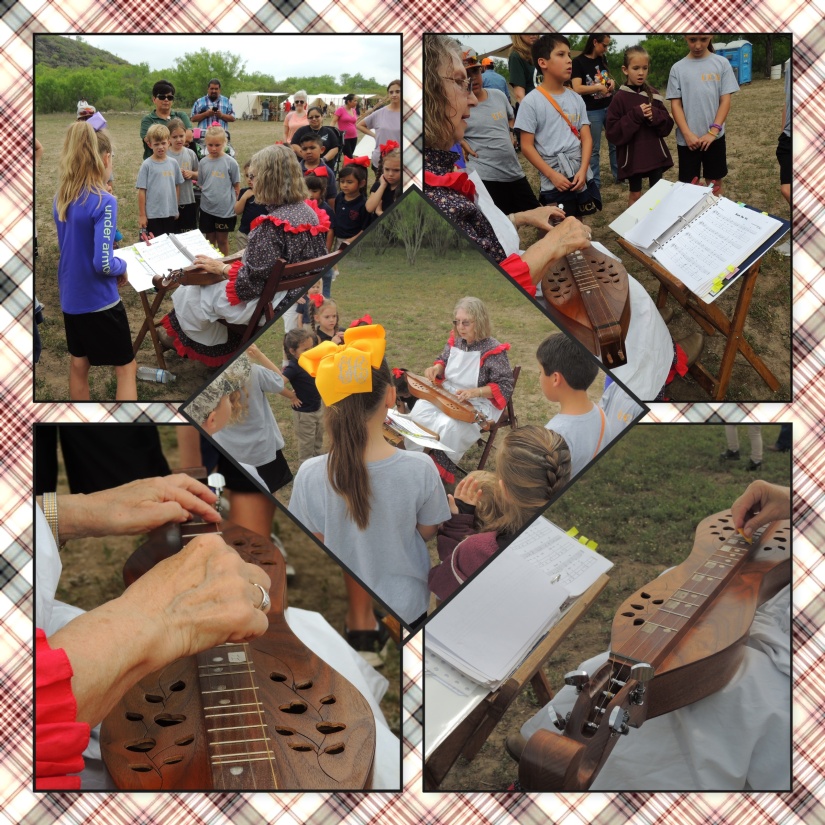
…who played beautiful music for the students. What a treat! She took requests and played her instrument flawlessly while all the kids sang along, hymns and popular songs of the period that the children would be familiar with.
.
The last stop on our visit was around the hedgerow to see the camels…
Please click on the link to learn more about the US Army’s Great Camel Experiment from this Facebook Page.
Our guide for this Camel exhibit was very entertaining. He played a couple songs on his guitar and sang for us. He was very engaging. The kids really enjoyed him, but I think what they would have loved more would have been to touch and ride the camels!

.
We ended our visit with a final climb on the rocks by an old outbuilding…

…and then headed off to our own picnic lunch in the park in town!!!!!!
.
Thanks so much for stopping by and learning about our little town’s neat little old soldier fort. You’ll have to plan a visit out sometime during Living History Days in the spring. Also, you might like to visit Fort Clark in Brackettville. And if you can find it, this is a neat book written about Fort Inge that was given to us by relatives of the author.

Happy Trails y’all!!!
For more about Fort Inge visit Wikipedia.
And he said, “The LORD is my rock and my fortress and my deliverer; My God, my rock, in whom I take refuge; My shield and the horn of my salvation, my stronghold and my refuge; My savior, Thou dost save me from violence. “I call upon the LORD, who is worthy to be praised; And I am saved from my enemies.”
2 Samuel 22:2-4








